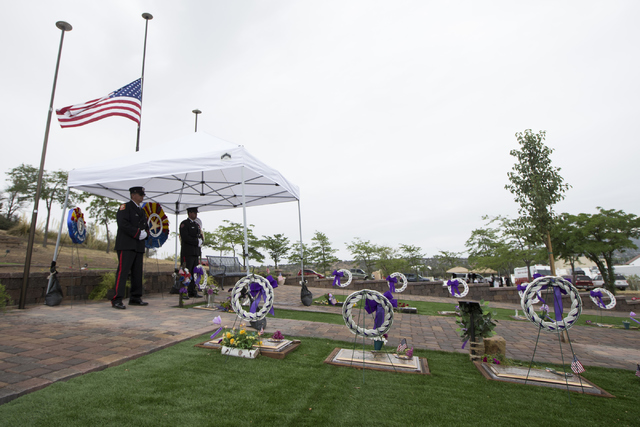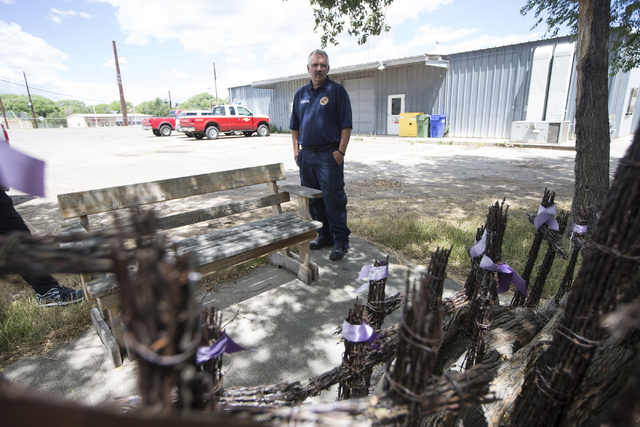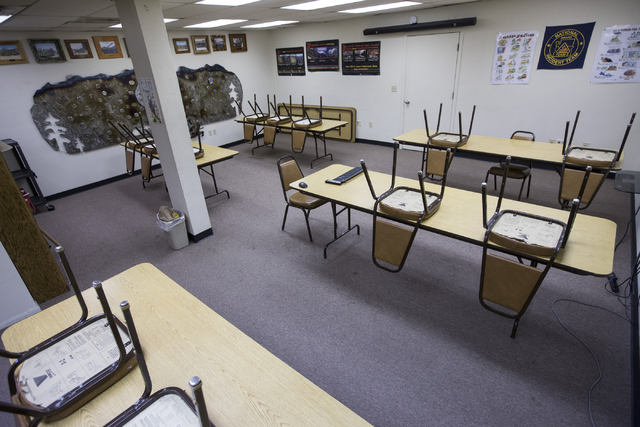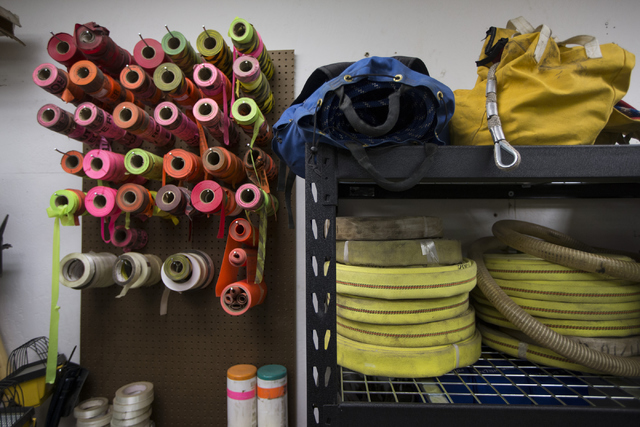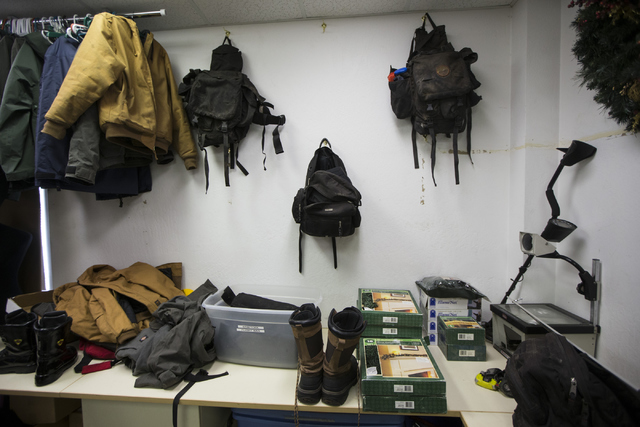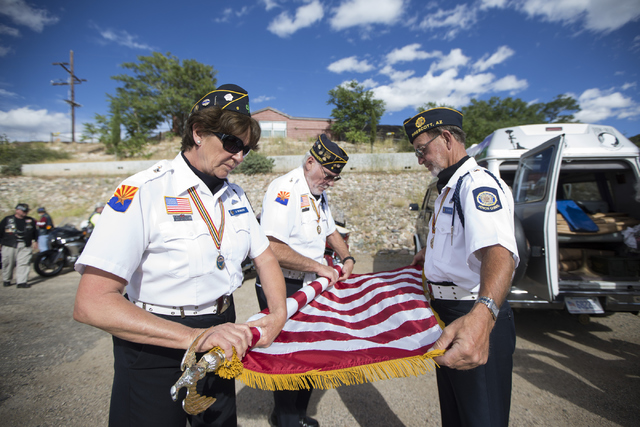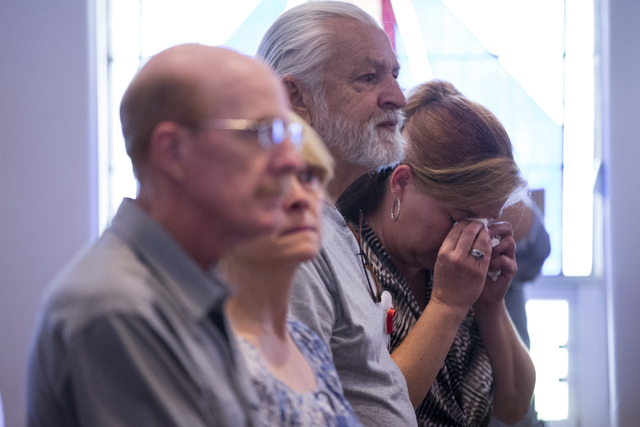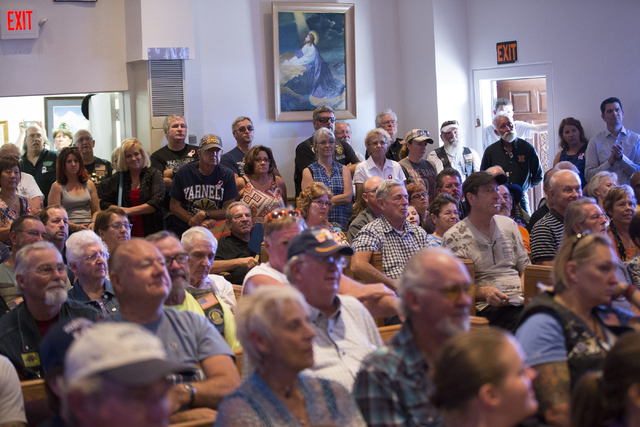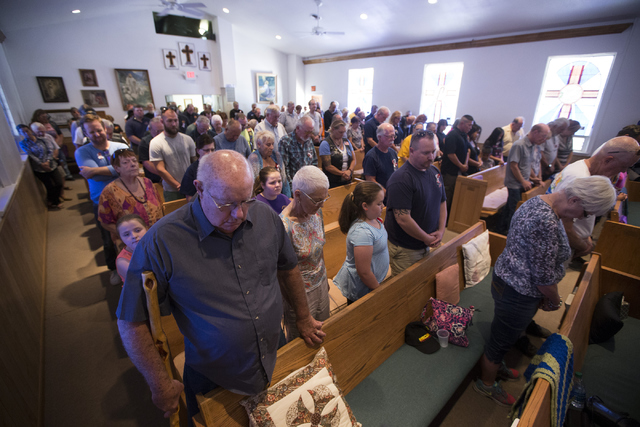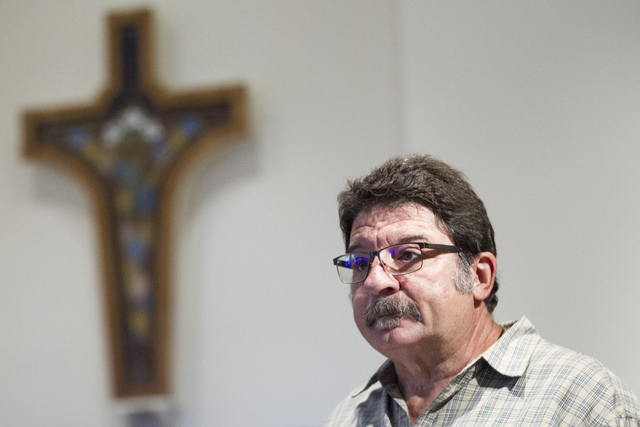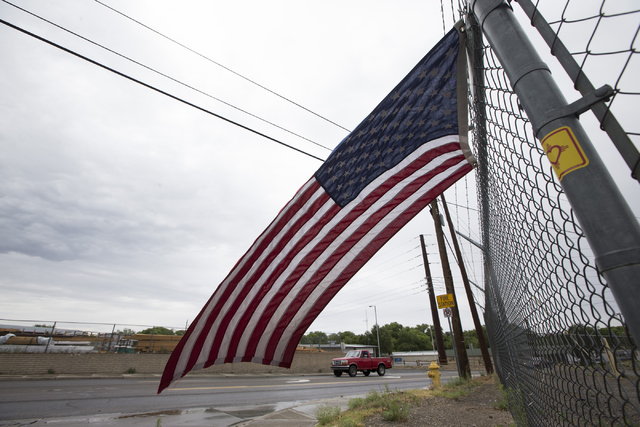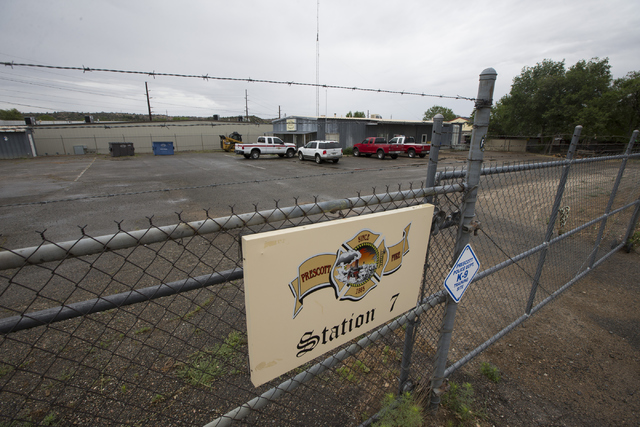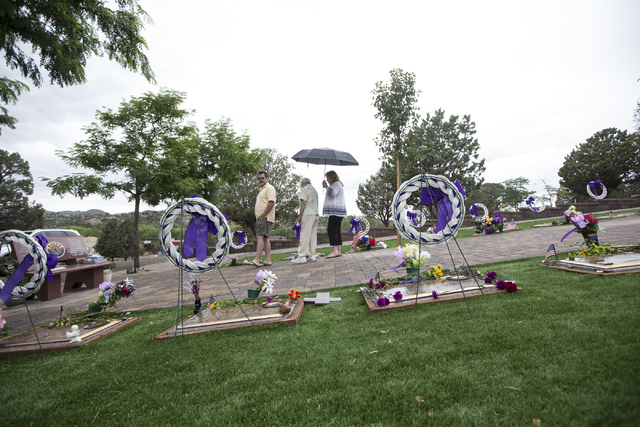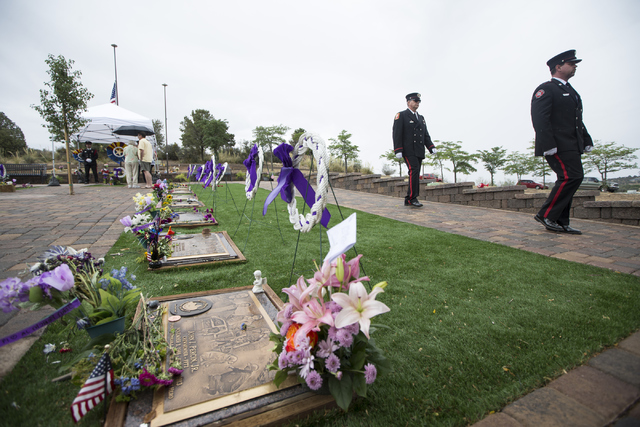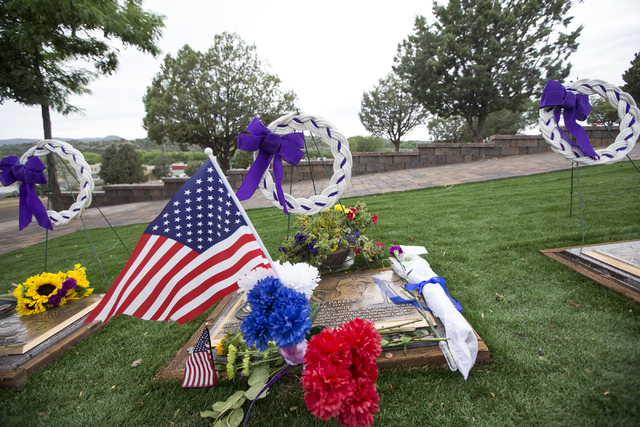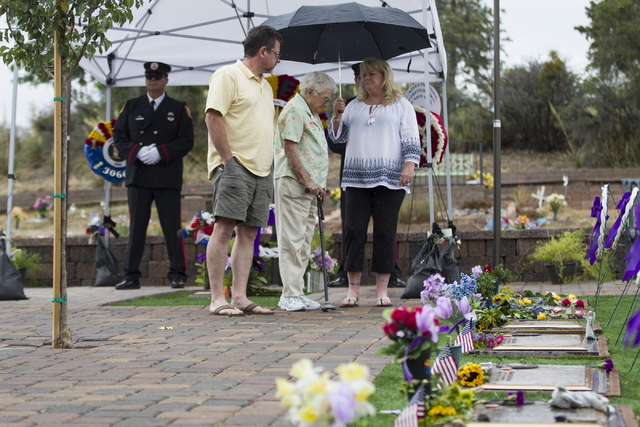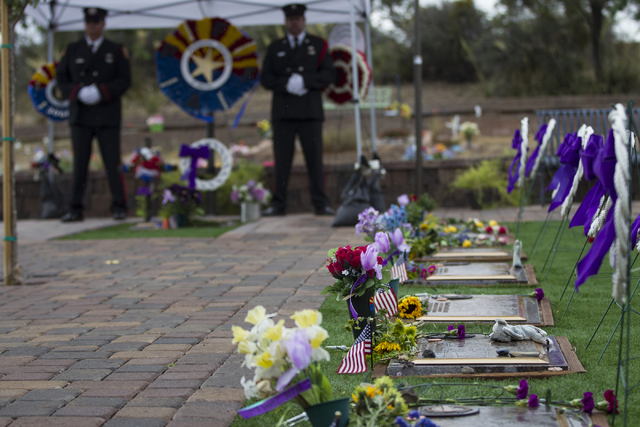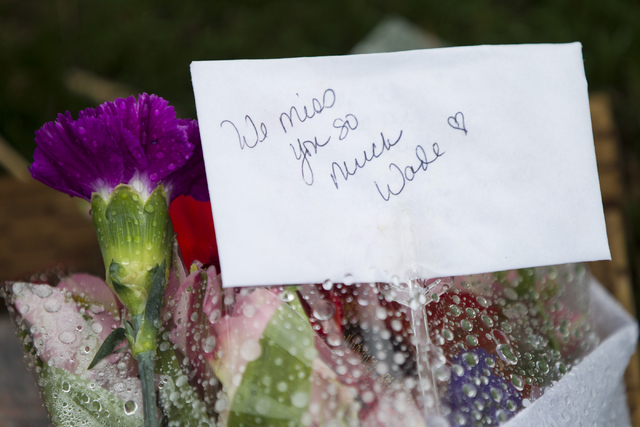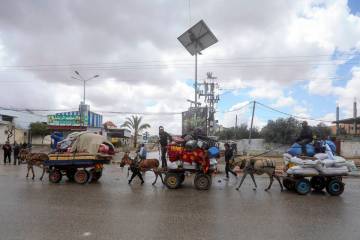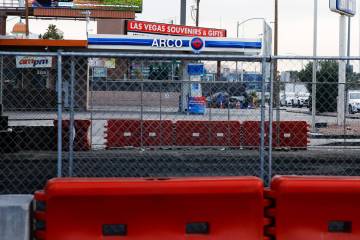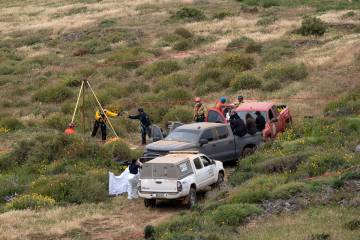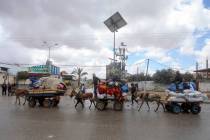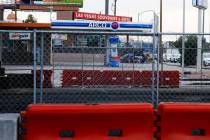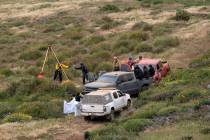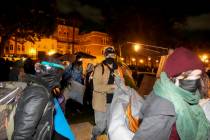Arizona town honors ‘The 19’ firefighters who died battling wildfire 3 years ago
YARNELL, Ariz.
Lew Theokas stood at the lectern inside a backcountry church filled to capacity; the wooden pews barely holding the 150 assembled mourners, let alone the ghosts of all those fallen firefighters.
Around here, they’re known simply as “The 19,” and on the afternoon of June 30, 2013, they died together while battling a wildfire that threatened to overtake this tiny former gold-mining town in the middle of a fire-prone national forest.
Their bodies were found huddled in a tight circle, after a storm-driven fire reversed course to unleash its fury upon the men, barely allowing them time to deploy their defensive fire shelters atop the scorched terrain on which they died.
They were all members of the elite Granite Mountain Interagency Hotshot Crew, the only city-run group of its kind nationwide, dispatched across the American West to battle only the most perilous, out-of-control wildfires. But on the day they died, this collection of men age 21 to 43 were fighting a conflagration only a few miles from home, amid soaring heat that often must have felt like the surface of Venus.
Theokas’ grandson — 27-year-old Garret Joseph Zuppiger — is among those who perished in the Yarnell Hill Fire, the nation’s biggest collective loss of firefighters since Sept. 11, 2001, and the highest from a U.S. wildfire in at least half a century.
Now the graying eighth-grade teacher and volunteer fireman stood before his community, asked to officiate the service because of his wry, self-deprecating wit and because people here know that, more than the scores who lost their homes in the blaze, he has endured the fire’s aftermath in a profoundly painful way.
There at the lectern, Theokas didn’t mention his grandson or any of the others by name. But the mourners knew who they were: fathers, sons, cousins and brothers, many of them lifelong Prescott natives, who left behind 11 children, 10 widows and three fiancées. Three were expecting newborns.
There was Zuppiger, a fun-loving outdoorsman who once mounted a recliner on skis to tour around the snow. And Travis Turbyfill, who carried a copy of the children’s book “Goodnight Moon” to read over the phone to his two young daughters at bedtime, as he huddled at a fire site during a break. And Sean Misner, a high school runner and football player from California whose parents spread his cremains around the valley near home.
The images they left behind are heartbreaking: A photograph of all 19 bodies laid side-by-side at the deployment site, covered by American flags. And that scene of their remains later being carried through Prescott in a somber procession that featured 19 hearses and a motorcade that stretched more than a mile long.
“Time has a habit of going on despite our tragedies and that is a good thing,” the 64-year-old Theokas told the Yarnell crowd. “But in the end, it has made us better people, and I will always try to remember that as I recall those young men who died that day.”
Three years after the deaths, Prescott and the surrounding area struggles to cope with a loss on such an unthinkable scale. Robert Brandon, a retired chief of the Peeples Valley Fire Department, said, “We lost an entire generation of young men that day.”
For a long time, the fire’s cruel circumstances hung heavy here. There were wrongful-death lawsuits totaling hundreds of millions of dollars (most of them now settled) and recriminations by the victims’ families, demanding to know why more wasn’t done to save the men’s lives.
Brendan McDonough, the lookout for the hotshot crew who escaped to become the day’s lone survivor, has written a book about his experience and is assisting in an upcoming movie on the downed crew. Online, many call him a shameless gold digger.
And numerous residents have begun to question the continuing memorials, saying it’s time for people to move on. This year brought a half-dozen events, including a moment of silence and ringing of 19 bells at the Prescott courthouse amid plans to build a trail to the site where the men perished, a place that has become sacred here, what one firefighter called “a tragic academy.” One resident has kept a row of 19 small American flags in his front yard for three years running.
In the end, an investigation found that the Arizona Division of Forestry committed “serious, willful violations” of workplace safety regulations, faulting the agency for not evacuating the men in the hours before their deaths. Prescott’s hotshot crew was dismantled in light of the tragedy.
Painful questions remain: Why did a well-trained crew of elite veterans suddenly leave a safe zone to enter the precarious box canyon where they were overtaken? Were they given a direct order? Or, as they fought a blaze in their own backyard, did they make a valiant yet miscalculated effort to head off a fire that had suddenly turned to threaten the nearby homes of friends and neighbors?
“Nobody knows,” said state Forestry Division spokesman Bill Boyd. “The only people with the answer to that question are now in heaven.”
■ ■ ■
The 19 men must have known they were going to die.
They had trained for years just for this moment: the possibility that an erratic wildfire would trap them. Their only hope was to lie down beneath their flame-resistant blankets and pray the onrushing flames would sweep over them, not through them.
The fire had started two days before, set ablaze by a lightning strike, but none of the city, state and federal fire agencies monitoring the area took it seriously. It was Type III, nothing to worry about. Around Arizona, another 36 active fires were of bigger concern.
But that morning, a sunny Sunday in early summer, the stubborn fire had grown to 1,500 acres as it devoured the parched scrub brush. The hotshots were called in.
By noon, the crew had arrived in their fire buggies to establish a main safety zone at a ranch just southwest of Yarnell and Peeples Valley. In triple-digit heat, they moved toward the flames, wearing heavy protective gear, lugging 50 pounds of equipment. At 2 p.m., the National Weather Service in Flagstaff warned of an approaching storm.
“We could really use a little rain down here,” one hotshot texted his family. Two hours later, a major thunderstorm was upon them. Homes in Yarnell and elsewhere were evacuated. The experts knew that a storm could play tricks with a fire.
The crew had been working along a ridge when the winds suddenly changed direction, whipping the flames back around 180 degrees. As the winds howled, the crew was suddenly lost in swirling thick smoke. McDonough, the lookout, radioed supervisors that the situation was bad and that he was evacuating. Helicopter crews hovered overhead, trying to find the hotshots and dump water or a load of orange slurry to smother surrounding flames.
The scene was chaos.
The crew had apparently left a nearby safety area and headed back toward Yarnell, through a narrow box canyon. “They moved to do what they signed on to do — protect lives and property,” said Don Devendorf, a Prescott Fire Department division chief and former hotshot. “There would be no other reason.”
At 4:47 p.m., lead hotshot Eric Marsh, at 43 the eldest of the men, radioed in to say the crew was trapped. His voice was calm: “We’re deploying.”
So what did the men see, feel and hear as those lethal flames closed in?
Devendorf said the veterans realized the gravity of their situation, huddled beneath their fire shelters. Some must have prayed; others shouted encouragement.
“There’s no doubt they talked to each other,” he said. “They knew this was the most terror they would ever face. They were probably yelling, ‘Hang in there, buddy!’”
The flames sucked the oxygen from the air, making it nearly impossible to breathe. The heat became overwhelming.
“To think what those guys went through,” said retired Prescott Fire Chief Bruce Martinez. “I hope to God it was quick, and I think it was.”
At 5:30 p.m., a helicopter crew spotted the bodies, grouped together like on some weekend camping trip. There were 19 of them.
Later, most could be identified only by dental records, scars and tattoos.
■ ■ ■
The families of the dead firefighters eventually got the chance to vent their suspicions and question state fire supervisors.
On a daylong retreat earlier this year, the pilots who flew air support over the 2013 fire described for those gathered the hellish conditions on the ground that day.
Jeff Whitney, a top state fire official named to his post after the tragedy, was there.
“(The pilots) said this long tongue of flame just shot out and they’d never seen anything like it,” he told the Arizona Republic newspaper. “There are some family members who still have issues; I can’t fault any of them.”
Months before, a commission of workplace safety overseers blasted the Arizona Division of Forestry for its handling and oversight of the Yarnell Hill Fire. Officials knew the unpredictable storm was coming, but did not evacuate the men, exposing them to “smoke, burns and death,” the panel’s report concluded.
The Arizona Industrial Commission also called for reforms in the way such wildfires are trained for, mapped out and fought. The measures include a firefighter course called “Reality of Death,” with instruction about estate planning.
“This meeting with officials is something the families felt they needed and wanted, state Forestry Division spokesman Bill Boyd. “There have been investigations, the legal settlements are completed. From our perspective, the books are closed.”
But not for everyone, including author John Maclean, who has written several books on wild land firefighting and is working on a book on the Yarnell Hill blaze.
He said investigators and reporters have combed documents in search of “the smoking gun” — the direct order from a fire supervisor directing the men to return to Yarnell to head off the fire. So far, none has been found.
“Still, there has to be a rational explanation why 19 veterans decided to leave a safe spot and go someplace else,” Maclean said. “Why did they do it?”
■ ■ ■
Brendan McDonough knows he always carry the mark: the one who went on living when the nine other Yarnell Hill firefighters died.
Especially in Prescott.
His tell-all book, “My Lost Brothers: The Untold Story by the Yarnell Hill Fire’s Lone Survivor” has brought ugly Internet attacks from people he dismisses as “keyboard warriors” who have never themselves faced a deadly blaze.
He has thought about leaving the area, but is staying put, buoyed by the support of many local residents.
“The label of the lone survivor; it will always be part of me but it’s not me,” he said. “I can’t let that be me.”
Others scarred by the fire also try to look forward.
At the recent memorial service, Robert Brandon, the retired Peeples Valley fire chief, talked about a recent blaze, the so-called Tenderfoot Fire, that had erupted near Yarnell, only to be extinguished quickly by aggressive local fire officials.
This time, there were no properties, or firefighters, lost.
“The idea was that we’re going to win this time,” he said, “not the fire.”
In his remarks, Lew Theokas, grandfather of Yarnell Hill firefighter Garret Zuppiger, described his reaction to the onset of the Tenderfoot blaze: “Oh God, not again.”
But, he added: “This time, we worked together; this time, we were better prepared; this time, help came swiftly and effectively; this time, it seems, we got it right. And maybe, just maybe, this time, we had 19 angels looking out for us.”
■ ■ ■
The ceremony that afternoon included rifle volleys in honor of “The 19.” As each of their names were read aloud, women swayed in place, as though in response to a powerful rush of emotions. Hulking men in cowboy boots leaned forward, their big shoulders trembling as they wept.
When it was over, several people hugged Theokas as though they would never let go.
“Garret was our future; he was the one,” he said of his grandson. “We were all looking forward to having him in our lives for a long time.”
He paused. “It’s such an overwhelming number. My God. All of them. All 19 of them.
“They’re gone.”



